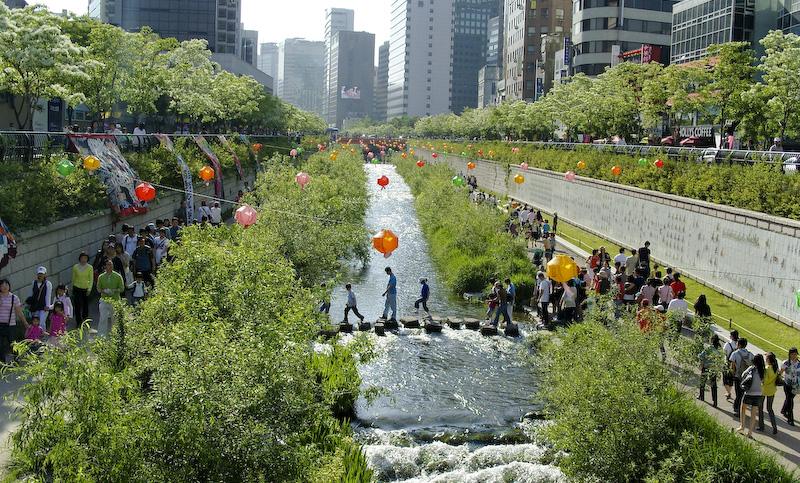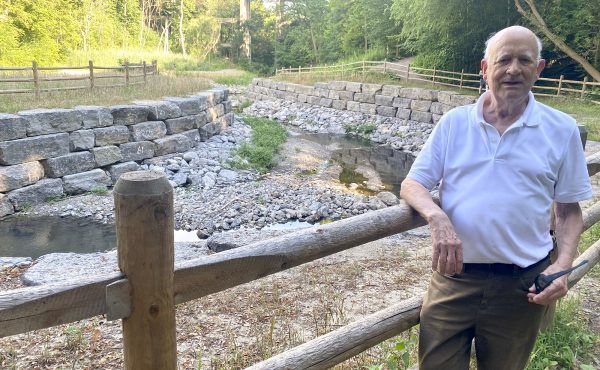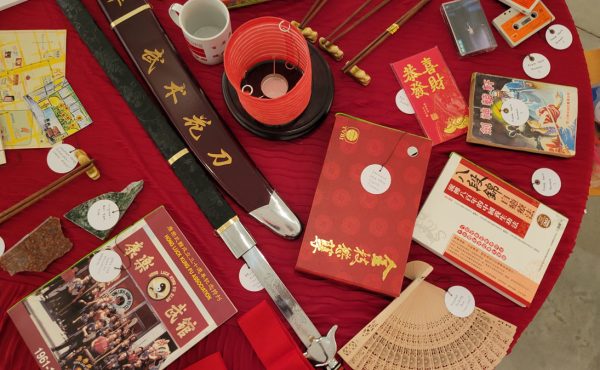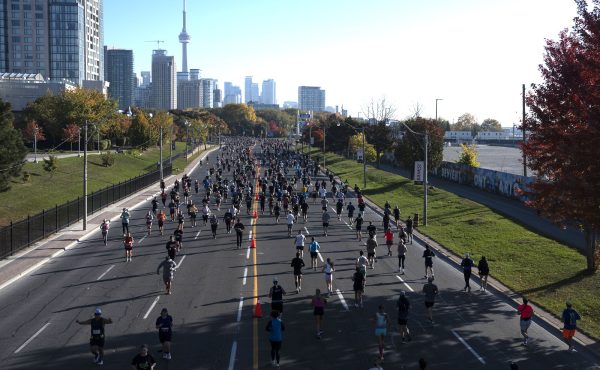Last week, with the Jarvis Street lane reduction still front and centre, we looked at the big strides New York is taking in increasing its bicycling infrastructure and the amount of public spaces in the city’s busiest spots. This week, with Jan Gehl’s visit, the Gardiner Expressway Environmental Assessment and questions surrounding the city’s waterfront fresh in our minds, I thought it would be interesting to look at what’s been going on in Seoul.
In 2002, Mayor Lee Myung-bak of the City of Seoul (now President of South Korea) pledged to tear down their version of the Gardiner Expressway, a six lane elevated highway going right through the centre of the city. Yet unlike the Gardiner, which carries from 40,000 to 60,000 cars daily, the expressway that cut through the world’s seventh largest city carried approximately 160,000 cars a day. And unlike the Gardiner, which merely cuts off the waterfront from city, in Seoul, the motorway was built directly over the Cheonggyecheon river (means “clear valley stream”), which was paved over to first make way for a massive boulevard (like our Lakeshore Boulevard) and then an elevated expressway overtop for a total of 16 lanes.


This all took place in the late 1960s and early 1970s, within a social and political climate far different to Toronto’s, yet nonetheless producing a strikingly similar product. Unlike Toronto, however, Seoul has now torn down their expressway and restored the Cheonggyecheon River to the city after citizens of the city approved the project in a vote. While Seoul residents were initially worried about traffic congestion getting worse and a loss of business, it seems that tearing down the expressway actually improved traffic in the city, proving what mathematicians and planners understand to be Braess’s Paradox.
The river was officially opened to the public in 2005, so I’ve collected a few articles and websites about the history of the river and its recent restoration. While not everyone is happy about the return of the river, specifically those people who were displaced or are currently excluded from riverbank (it isn’t wheelchair accessible), Seoul’s experiment in urban revitalization is being put forward as a model for other cities with expressways dissecting their downtowns.
With the Gardiner in mind and Toronto’s waterfront in the place of the Cheonggyecheon, should Seoul’s Cheonggyecheon redevelopment be a model for Toronto? How likely is it that Toronto will also experience Braess’s Paradox, which is said to be just as likely to occur as it is not to occur? Or what about reclaiming some of Toronto’s lost rivers with a similar project?
Articles
• Heart and soul of the city [The Guardian]
• Cheonggyecheon [The Vigorous North Blog]
• Saving Seoul [TIMEasia Magazine]
• South Korea Trades Dirty Expressway for Amazing 6km Greenway [EcoWorldly]
• Official Cheonggyecheon Restoration Project Website
• Cheonggyecheon Restoration in Seoul (the Beginning and After) [Yonsei University Korea]
• Daylighting in the heart of Seoul: The Cheong Gye Cheon Project [L.A. Creek Freak Blog]
Videos
• Seoul: the stream of consciousness [PBS documentary]
• Cheonggyecheon by day [Vimeo]
Photos by Ben Harris-Roxas and Wikimedia






18 comments
I don’t think it should be a model, but rather an example of just what can be done in a situation that seems very similar to ours. But I think there is more to this story than presented here. Removing all those lanes and yet experiencing improvements in traffic makes me wonder what alternative modes of transportation were added onto their system in its place. Did they add more bike paths/lanes? Did they add onto their transit system? How did all those people suddenly find another way to get to where they had to go when the expressway was still there? I think just taking away an expressway and placing a beautiful park in its place is just one part of a large initiative that this city has clearly undertaken to have such successful results. If Toronto can provide similar improvements for alternatives to getting around the city in a similarly coordinated way then I think -only then – it may be able to experience the same results as Seoul.
Stunning. What else can one say? Dream big, Toronto.
Clearly if we want to demolish the Gardiner (particularly if we ever consider doing so to the western section) we will have to invest heavily in improving GO Transit. Otherwise we will end up with traffic chaos.
I currently live in Seoul, having transplanted myself from Toronto to here for the last year or so. I’m not particularly sure that the Cheonggyecheon or Seoul are entirely appropriate models for the Gardiner redevelopment. While the results have been pretty nice, I feel that the circumstances to which it being a success are different than those that currently exist in Toronto. If we are to use the Cheonggyecheon and Seoul as a model, then we have to keep multiple things in mind before we proceed
I’ll start off with land use issues. Firstly, the Cheonggyecheon is located in the heart of ancient Seoul, the old city part that now features among other things, the political and tourist areas of the city. Seoul is not like Toronto. It’s not a city with one central core (ie Bathurst/Bloor/Broadview/the harbour), but one of many cores. As I mentioned before, the part that Cheonggyecheon is in goes through an area of primarily government buildings and tourist sites, as well as a few solid shopping areas at Myeongdong and Dongdaemun. Seoul’s business core is located on Yeuido, an island south of the river, a good 30 minutes away from the Cheonggyecheon by subway. Its premiere shopping districts are south of the river in Gangnam and Apgujeong while its theatre district is up north in Hyehwa. Its clubbing and partying scene is out west in Hongdae and Ewha. Its train hubs are at Yongsan and Seoul Station, south of the Cheonggyecheon by 10-15 minutes on the subway. Its stadiums and sporting complexes are flung all over the city, the closest – the World Cup Stadium (for soccer) being at least 30 minutes away by subway, and its other sporting complexes (baseball and basketball) probably being around 40 minutes away. This is not a compact city, but one that has many cores, and many different hubs, with people travelling in many different directions at all times. It’s not the 9-5 inbound/outbound city that Toronto is.
Why is this important? Because while you mentioned that 160,000 cars drove on this highway each day, the overall importance of this road to Seoul is not nearly as critical as the Gardiner is to Toronto, mostly because its core is so spread out and because the direction of traffic is not uni-directional. Furthermore, it helps to pay in mind the fact that the greater Seoul area has nearly 4 times as many people as Toronto’s does, which should tell you something about the statistics that were listed.
Secondly, the availability of public transit in Seoul is far greater than it is in Toronto. While I have many issues with transit in Seoul (20 minute headways at night, 6 minute headways at rush hour, stations that were designed by sadists, trains that smell like kimchi and garlic etc), it’s far easier to take transit where you want to go in this city than it is to drive. Not only are people incapable of driving, but the traffic is astoundingly bad. I once took a bus across the river that normally would’ve taken 20 minutes by subway but took me nearly an hour by bus. And this was a Sunday morning at 11AM. Commuting by TTC or GO into Toronto from the inner or outer suburbs is generally not faster than it is driving into the city. Furthermore, the highway on top of the Cheonggyecheon was never a through highway. It terminated at Sejong Road within the core, unlike the Gardiner which continues its way out to Niagara Falls. If Toronto is serious about taking down the Gardiner, it also needs to be serious about providing alternatives that are equal if not better than driving downtown. The highway on top of the Cheonggyecheon ran east-west. Seoul has nearly 5 subway lines running parallel to the stream at its busiest areas and 2-3 in its less busy areas, with literally dozens of bus lines criss-crossing, connecting northern areas of Seoul to southern areas. Toronto would need to invest heavily to make the loss of the Gardiner acceptable to people commuting in, whether it be by building subway lines to the inner and outer suburbs, or by increasing GO train frequencies.
Thirdly, the comparisons between the Gardiner and the Cheonggyecheon highway are fundamentally flawed by the fact that the highway in Seoul actually no longer exists in any sort of capacity. The two roads that flank the stream now (both one-way) are not heavily used boulevards or avenues, which runs contrary to what people want the Gardiner to become in Toronto. They are merely just roads, normal roads, two laned ones that one can jay-walk easily due to lack of traffic.
If we want the Gardiner to become a pedestrian-friendly urban boulevard that greets incoming suburban traffic, modelling it after two lightly-used streets flanking a stream that terminates within the core of the city is not helpful nor useful. What we can take from the Cheonggyecheon however, is the inspiration and idealism to do better.
I currently live in Seoul, having transplanted myself from Toronto to here for the last year or so. I’m not particularly sure that the Cheonggyecheon or Seoul are entirely appropriate models for the Gardiner redevelopment. While the results have been pretty nice, I feel that the circumstances to which it being a success are different than those that currently exist in Toronto. If we are to use the Cheonggyecheon and Seoul as a model, then we have to keep multiple things in mind before we proceed
I’ll start off with land use issues. Firstly, the Cheonggyecheon is located in the heart of ancient Seoul, the old city part that now features among other things, the political and tourist areas of the city. Seoul is not like Toronto. It’s not a city with one central core (ie Bathurst/Bloor/Broadview/the harbour), but one of many cores. As I mentioned before, the part that Cheonggyecheon is in goes through an area of primarily government buildings and tourist sites, as well as a few solid shopping areas at Myeongdong and Dongdaemun. Seoul’s business core is located on Yeuido, an island south of the river, a good 30 minutes away from the Cheonggyecheon by subway. Its premiere shopping districts are south of the river in Gangnam and Apgujeong while its theatre district is up north in Hyehwa. Its clubbing and partying scene is out west in Hongdae and Ewha. Its train hubs are at Yongsan and Seoul Station, south of the Cheonggyecheon by 10-15 minutes on the subway. Its stadiums and sporting complexes are flung all over the city, the closest – the World Cup Stadium (for soccer) being at least 30 minutes away by subway, and its other sporting complexes (baseball and basketball) probably being around 40 minutes away. This is not a compact city, but one that has many cores, and many different hubs, with people travelling in many different directions at all times. It’s not the 9-5 inbound/outbound city that Toronto is.
Why is this important? Because while you mentioned that 160,000 cars drove on this highway each day, the overall importance of this road to Seoul is not nearly as critical as the Gardiner is to Toronto, mostly because its core is so spread out and because the direction of traffic is not uni-directional. Furthermore, it helps to pay in mind the fact that the greater Seoul area has nearly 4 times as many people as Toronto’s does, which should tell you something about the statistics that were listed.
Secondly, the availability of public transit in Seoul is far greater than it is in Toronto. While I have many issues with transit in Seoul (20 minute headways at night, 6 minute headways at rush hour, stations that were designed by sadists, trains that smell like kimchi and garlic etc), it’s far easier to take transit where you want to go in this city than it is to drive. Not only are people incapable of driving, but the traffic is astoundingly bad. I once took a bus across the river that normally would’ve taken 20 minutes by subway but took me nearly an hour by bus. And this was a Sunday morning at 11AM. Commuting by TTC or GO into Toronto from the inner or outer suburbs is generally not faster than it is driving into the city. Furthermore, the highway on top of the Cheonggyecheon was never a through highway. It terminated at Sejong Road within the core, unlike the Gardiner which continues its way out to Niagara Falls. If Toronto is serious about taking down the Gardiner, it also needs to be serious about providing alternatives that are equal if not better than driving downtown. The highway on top of the Cheonggyecheon ran east-west. Seoul has nearly 5 subway lines running parallel to the stream at its busiest areas and 2-3 in its less busy areas, with literally dozens of bus lines criss-crossing, connecting northern areas of Seoul to southern areas. Toronto would need to invest heavily to make the loss of the Gardiner acceptable to people commuting in, whether it be by building subway lines to the inner and outer suburbs, or by increasing GO train frequencies.
Thirdly, the comparisons between the Gardiner and the Cheonggyecheon highway are fundamentally flawed by the fact that the highway in Seoul actually no longer exists in any sort of capacity. The two roads that flank the stream now (both one-way) are not heavily used boulevards or avenues, which runs contrary to what people want the Gardiner to become in Toronto. They are merely just roads, normal roads, two laned ones that one can jay-walk easily due to lack of traffic.
If we want the Gardiner to become a pedestrian-friendly urban boulevard that greets incoming suburban traffic, modelling it after two lightly-used streets flanking a stream that terminates within the core of the city is not helpful nor useful. What we can take from the Cheonggyecheon however, is the inspiration and idealism to do better.
I hope the elevated portion of the Gardiner is taken down but I hope that we have some sort of ground level boulevard so that traffic can still move through this city. maybe the new version of the Gardiner could be in a trench with the downtown portion in a tunnel.
Tim, thanks for the excellent analysis. Indeed, Toronto needs to promote development along existing transit lines and build more transit, instead of lumping everything into the single core. We have a few up and coming, most notably North York center, but those are not nearly enough.
Thanks Tim for giving us that additional information. Context definitely plays a huge role in these sorts of situations and now we can look at this case in a more well-informed and realistic way.
As of now it doesn’t seem like Toronto is similar to Seoul at all, but I wonder if it might become similar in the future since we are also aiming to have multiple cores around the city and more transit connections throughout. Maybe in the future, after these improvements are in place and have matured, the Gardiner/Lakeshore won’t be as important and this could be a possibility?
Tim’s comments I think are very thoughtful and thorough, but I would make one counter-argument. When he says unlike the Gardiner which continues its way out to Niagara Falls he makes the mistake of misunderstanding the Gardiner, which is not primarily a through road. The through traffic on the Gardiner (those travelling from, say, Don Mills to Parkdale) is largely insignificant, given the alternative of the 401/427. The Gardiner overwhelmingly feeds downtown and one of the reasons we are able to consider getting rid of it is that a model where downtown traffic is funnelled to a Don Valley Parkway and the Gardiner on either side of downtown may be enough, indeed, may be superior in some ways to the Gardiner.
I say “may be”, because I think we need to study this issue to be certain. But to characterize the Gardiner as a through road, I think, is misleading.
Anyways, great article and thoughtful responses.
A quibble with the post: it compares volumes on the Gardiner (stated as 40-60k per day) to the Seoul example (160k), with the implication that if Seoul could do it at 160k, doing it for the Gardiner should be child’s play since the volumes are so much lower.
The Gardiner’s volumes are actually closer to 100k in the section west of the DVP (plus traffic on Lake Shore, maybe 15k), the section that’s being considered for modification. The section entering downtown from the west is closer to 150-160k, in line with the Seoul volumes (again, plus Lake Shore, which adds another 40-45k). (These are from traffic volume maps off the City’s web site.)
No one’s mentioned it yet, but Seoul did revamp its entire bus system at about the same time as it was reclaiming the river. All of the bus numbers were changed. Bus-only lanes were designated. So while the subway is still far more efficient, at least Seoul’s buses are much, much, much more helpful than they used to be.
I can say from personal experience that the reconstructed Cheonggyecheon is an exciting and extremely well used urban destination. Despite the hoards of people lining the walking paths and playing in the stream during most hours of the day, the Cheonggyecheon still manages to feel like a tranquil oasis deep inside one of the world’s most populated and congested cities.
This is not to say that the project has much merit in terms of its contribution towards environmental sustainability, however, it has provided Koreans with a source of pride in their city and the plaques along the paths have helped educate the masses about the long history of Seoul.
For anyone interested in more information regarding the Cheonggyecheon, I wrote a fairly extensive article a couple years back when I was living in Seoul.
Enjoy:
http://www.urbanphoto.net/blog/2007/02/08/cheonggyecheon-the-flow-of-progress/
I can also say from personal experience, Cheonggyecheon was a vanity project by an unlikeable man in a bid for presidency which later worked. (Lee Myungbag incidentally was also one of the people responsible for covering up the stream in the first place).
For some reason after this the guy was named environmentalist of the year by Time Magazine or something. Ironic then that if there’s a power failure, the water will drain out and disappear. It’s nothing more than a six-km-long concrete fountain. Ironically the elevated roadway which eased traffic was far better for the environment than this disaster.
As mayor of the city, Lee Myungbag built this stream through it. As president of the country, he planned to build a canal from Seoul to Busan. If you don’t immediately get how ridiculous this is, go look at a map of the country.
Jon, I agree with your criticisms of the project and of Lee Myung Bak. There were certainly political motivations behind ‘uncovering’ the Cheongyecheon, and it really doesn’t represent environmental stewardship when the water that flows up the stream is diverted from the Han River and filtered and pumped through a new treatment facility plant (constructed to facilitate the gimmicky waterfalls and to allow people to splash around in clean water, etc). Overall, it’s a bad project, however I must say that it’s aesthetically pleasing, extremely popular, and many residents of Seoul seem to be quite proud of it.
Thanks very much for the attribution of the photo. Having been to Cheonggyecheon I’d like to agree with Tim and Jon’s excellent points. Many of the negative impacts, particularly the social impacts, on residents who lived in the area prior to the redevelopment, are glossed over when telling the story of the project. That being said it has created a very popular open space in the heart of Seoul (albeit an entirely artificial one). Cheonggyecheon strikes me as an interesting example of the increaingly difficult series of trade-offs that will have to be made in order to plan liveable cities.
Bob Krawczyk “The Gardiner overwhelmingly feeds downtown and one of the reasons we are able to consider getting rid of it is that a model where downtown traffic is funnelled to a Don Valley Parkway and the Gardiner on either side of downtown may be enough, indeed, may be superior in some ways to the Gardiner. ”
The Gardiner is as much, if not more important as a route for Torontoians to leave the city for work as the opposite.
Look at the traffic flow maps….
http://www.toronto.ca/transportation/index.htm
Compare AM and PM flows at the Gardiner at the DVP.
Sorry I meant to compare Gardiner flows at the 427. PM flows, which would be a better indication of aggregate demand, show inward PM flows at the 427 of 9,047 and outbound at 8,361. Move over to Spadina, the fist downtown inbound exit and the flows are: 4,419 inbound and 4,142 outbound.
This is using survey data from 2006. Since then a number of condo developments have been completed while few jobs have been created. If more current data was used, the bias towards higher PM inflows would be even more pronounced.
What is troubling about Mayor Miller’s trip is that he seems to be seeking justification for a preordained desire. That is to tear down the Gardiner. With such poor due diligence he might as well take a trip to Hawaii to study the feasibility of growing pineapples in Toronto. After all they can do it there.
One more important point against Cheonggyecheon, it may not have looked as nice before (personally I find the current Cheonggyecheon stale), but along with the tons of people who were displaced, Seoul lost one of its most interesting underground markets, and one of the last places left to get old vinyl.
Incidentally, some of the vendors were moved into Dongdaemoon Market, where Lee Myungbag promised them they could stay indefinitely. Then as soon as he moved on to the presidency, his successor evicted the vendors (violently, using an army of hired goons). I’m sure in a few years the design park they’re building in its place will be appearing on websites like this as well.